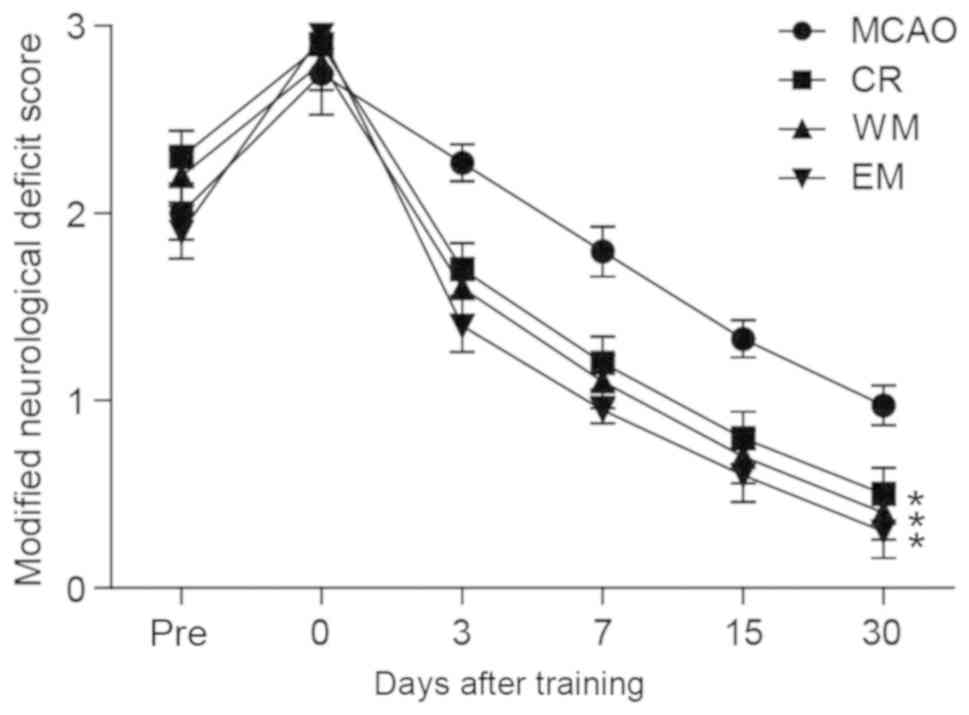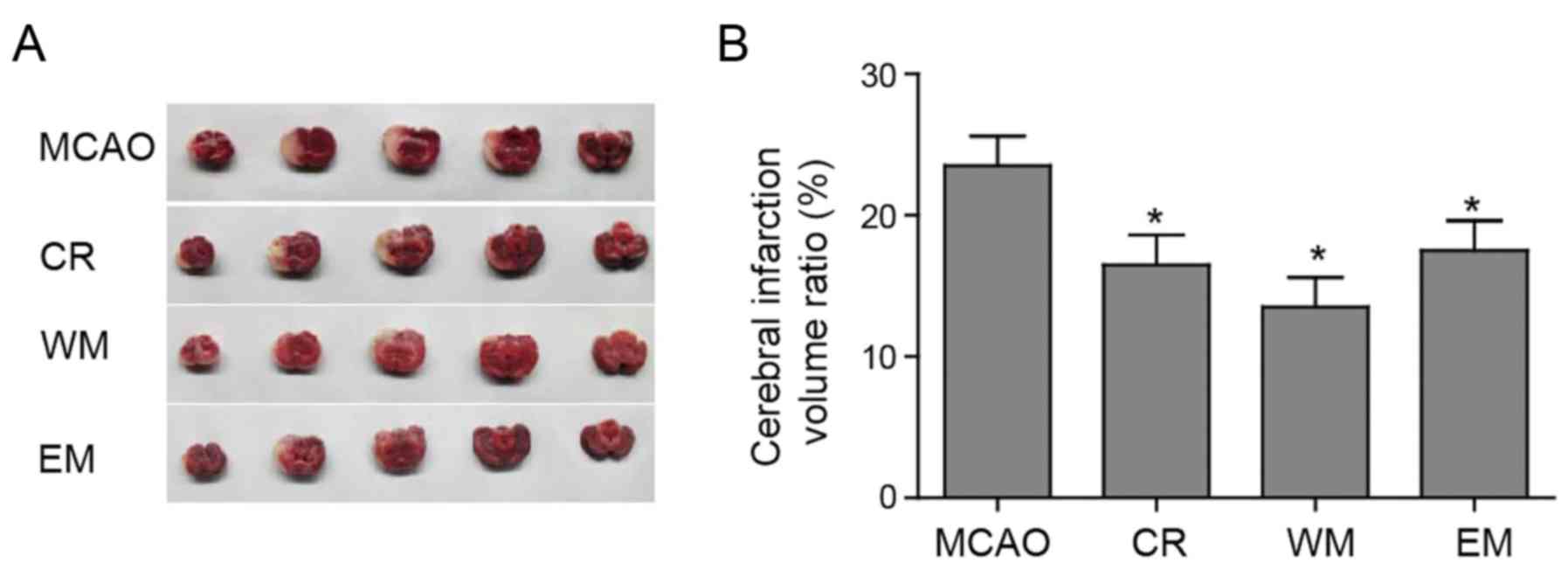|
1
|
Zhang JH, Li JK, Ma LL and Lou JY: RNA
interference-mediated silencing of S100B improves nerve function
recovery and inhibits hippocampal cell apoptosis in rat models of
ischemic stroke. J Cell Biochem. 119:8095–8111. 2018. View Article : Google Scholar : PubMed/NCBI
|
|
2
|
Nie J, Yang X, Tang Q, Shen Q and Li S:
Willed-movement training reduces brain damage and enhances synaptic
plasticity related proteins synthesis after focal ischemia. Brain
Res Bull. 120:90–96. 2016. View Article : Google Scholar : PubMed/NCBI
|
|
3
|
Navone SE, Marfia G, Nava S, Invernici G,
Cristini S, Balbi S, Sangiorgi S, Ciusani E, Bosutti A, Alessandri
G, et al: Human and mouse brain-derived endothelial cells require
high levels of growth factors medium for their isolation, in vitro
maintenance and survival. Vasc Cell. 5:102013. View Article : Google Scholar : PubMed/NCBI
|
|
4
|
Yu QJ, Tao H, Wang X and Li MC: Targeting
brain microvascular endothelial cells: A therapeutic approach to
neuroprotection against stroke. Neural Regen Res. 10:1882–1891.
2015. View Article : Google Scholar : PubMed/NCBI
|
|
5
|
Guell K and Bix GJ: Brain endothelial cell
specific integrins and ischemic stroke. Exp Rev Neurother.
14:1287–1292. 2014. View Article : Google Scholar
|
|
6
|
Waterland JC: The supportive framework for
willed movement. Am J Phys Med. 46:266–279. 1967.PubMed/NCBI
|
|
7
|
Tang Q, Yang Q, Hu Z, Liu B, Shuai J, Wang
G, Liu Z, Xia J and Shen X: The effects of willed movement therapy
on AMPA receptor properties for adult rat following focal cerebral
ischemia. Behav Brain Res. 181:254–261. 2007. View Article : Google Scholar : PubMed/NCBI
|
|
8
|
Tang Q, Tan L, Yang X, Shen Q, Huang X,
Wang G, Chen H, Nie J, Li S and Wu L: Willed-movement training
reduces motor deficits and induces a PICK1-dependent LTD in rats
subjected to focal cerebral ischemia. Behav Brain Res. 256:481–487.
2013. View Article : Google Scholar : PubMed/NCBI
|
|
9
|
Volk L, Kim CH, Takamiya K, Yu Y and
Huganir RL: Developmental regulation of protein interacting with C
kinase 1 (PICK1) function in hippocampal synaptic plasticity and
learning. Proc Natl Acad Sci USA. 107:21784–21789. 2010. View Article : Google Scholar : PubMed/NCBI
|
|
10
|
Clem RL, Anggono V and Huganir RL: PICK1
regulates incorporation of calcium-permeable AMPA receptors during
cortical synaptic strengthening. J Neurosci. 30:6360–6366. 2010.
View Article : Google Scholar : PubMed/NCBI
|
|
11
|
Moretti A, Ferrari F and Villa RF:
Pharmacological therapy of acute ischaemic stroke: Achievements and
problems. Pharmacol Ther. 153:79–89. 2015. View Article : Google Scholar : PubMed/NCBI
|
|
12
|
Thirusangu P, Vigneshwaran V, Ranganatha
VL, Vijay Avin BR, Khanum SA, Mahmood R, Jayashree K and Prabhakar
BT: A tumoural angiogenic gateway blocker, Benzophenone-1B
represses the HIF-1α nuclear translocation and its target gene
activation against neoplastic progression. Biochem Pharmacol.
125:26–40. 2017. View Article : Google Scholar : PubMed/NCBI
|
|
13
|
Lu Y, Wang B, Shi Q, Wang X, Wang D and
Zhu L: Brusatol inhibits HIF-1 signaling pathway and suppresses
glucose uptake under hypoxic conditions in HCT116 cells. Sci Rep.
6:391232016. View Article : Google Scholar : PubMed/NCBI
|
|
14
|
Sharp FR and Bernaudin M: HIF1 and oxygen
sensing in the brain. Nat Rev Neurosci. 5:437–448. 2004. View Article : Google Scholar : PubMed/NCBI
|
|
15
|
Hirota K and Semenza GL: Regulation of
angiogenesis by hypoxia-inducible factor 1. Crit Rev Oncol Hematol.
59:15–26. 2006. View Article : Google Scholar : PubMed/NCBI
|
|
16
|
Sun Y, He W and Geng L: Neuroprotective
mechanism of HIF-1α overexpression in the early stage of acute
cerebral infarction in rats. Exp Ther Med. 12:391–395. 2016.
View Article : Google Scholar : PubMed/NCBI
|
|
17
|
Phillips PG, Birnby LM and Narendran A:
Hypoxia induces capillary network formation in cultured bovine
pulmonary microvessel endothelial cells. Am J Physiol.
268:L789–L800. 1995.PubMed/NCBI
|
|
18
|
Krishnamachary B, Berg-Dixon S, Kelly B,
Agani F, Feldser D, Ferreira G, Iyer N, LaRusch J, Pak B, Taghavi P
and Semenza GL: Regulation of colon carcinoma cell invasion by
hypoxia-inducible factor 1. Cancer Res. 63:1138–1143.
2003.PubMed/NCBI
|
|
19
|
Hirayama Y and Koizumi S:
Hypoxia-independent mechanisms of HIF-1α expression in astrocytes
after ischemic preconditioning. Glia. 65:523–530. 2017. View Article : Google Scholar : PubMed/NCBI
|
|
20
|
Li Y, Xu L, Zeng K, Xu Z, Suo D, Peng L,
Ren T, Sun Z, Yang W, Jin X and Yang L: Propane-2-sulfonic acid
octadec-9-enyl-amide, a novel PPARα/γ dual agonist, protects
against ischemia-induced brain damage in mice by inhibiting
inflammatory responses. Brain, Behav Immun. 66:289–301. 2017.
View Article : Google Scholar
|
|
21
|
Kuo CH, Chen PK, Chang BI, Sung MC, Shi
CS, Lee JS, Chang CF, Shi GY and Wu HL: The recombinant lectin-like
domain of thrombomodulin inhibits angiogenesis through interaction
with Lewis Y antigen. Blood. 119:1302–1313. 2012. View Article : Google Scholar : PubMed/NCBI
|
|
22
|
Livak KJ and Schmittgen TD: Analysis of
relative gene expression data using real-time quantitative PCR and
the 2(-Delta Delta C(T)) method. Methods. 25:402–408. 2001.
View Article : Google Scholar : PubMed/NCBI
|
|
23
|
Chassagnon IR, McCarthy CA, Chin YK,
Pineda SS, Keramidas A, Mobli M, Pham V, De Silva TM, Lynch JW,
Widdop RE, et al: Potent neuroprotection after stroke afforded by a
double-knot spider-venom peptide that inhibits acid-sensing ion
channel 1a. Proc Natl Acad Sci USA. 114:3750–3755. 2017. View Article : Google Scholar : PubMed/NCBI
|
|
24
|
Piret JP, Lecocq C, Toffoli S, Ninane N,
Raes M and Michiels C: Hypoxia and CoCl2 protect HepG2 cells
against serum deprivation- and t-BHP-induced apoptosis: A possible
anti-apoptotic role for HIF-1. Exp Cell Res. 295:340–349. 2004.
View Article : Google Scholar : PubMed/NCBI
|
|
25
|
Zhang L, Luo X, Chen F, Yuan W, Xiao X,
Zhang X, Dong Y, Zhang Y and Liu Y: LncRNA SNHG1 regulates
cerebrovascular pathologies as a competing endogenous RNA through
HIF-1α/VEGF signaling in ischemic stroke. J Cell Biochem.
119:5460–5472. 2018. View Article : Google Scholar : PubMed/NCBI
|
|
26
|
Sasabe E, Tatemoto Y, Li D, Yamamoto T and
Osaki T: Mechanism of HIF-1alpha-dependent suppression of
hypoxia-induced apoptosis in squamous cell carcinoma cells. Cancer
Sci. 96:394–402. 2005. View Article : Google Scholar : PubMed/NCBI
|
|
27
|
Li J, Zhang X, Sejas DP, Bagby GC and Pang
Q: Hypoxia- induced nucleophosmin protects cell death through
inhibition of p53. J Biol Chem. 279:41275–41279. 2004. View Article : Google Scholar : PubMed/NCBI
|
|
28
|
Baranova O, Miranda LF, Pichiule P,
Dragatsis I, Johnson RS and Chavez JC: Neuron-specific inactivation
of the hypoxia inducible factor 1 alpha increases brain injury in a
mouse model of transient focal cerebral ischemia. J Neurosci.
27:6320–6332. 2007. View Article : Google Scholar : PubMed/NCBI
|
|
29
|
Helton R, Cui J, Scheel JR, Ellison JA,
Ames C, Gibson C, Blouw B, Ouyang L, Dragatsis I, Zeitlin S, et al:
Brain-specific knock-out of hypoxia-inducible factor-1alpha reduces
rather than increases hypoxic-ischemic damage. J Neurosci.
25:4099–4107. 2005. View Article : Google Scholar : PubMed/NCBI
|




















